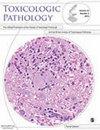生理性和病理性肥大大鼠心房ANP和BNP颗粒密度的比较
IF 1.4
4区 医学
Q3 PATHOLOGY
引用次数: 2
摘要
心房钠肽(ANP)和脑钠肽(BNP)是位于心房颗粒中的心脏激素。这两种多肽都对心脏压力和容量动态有反应,因此可以作为心力衰竭临床治疗的翻译生物标志物。血清ANP和BNP在血压和心输出量调节中发挥中枢秘书作用,并已被证明是心血管熟练程度和药物诱导的适应不良的差异生物标志物,但这两种肽都不受运动诱导的肥厚的影响。我们使用免疫电子显微镜观察了28天的慢性游泳运动或PPARγ激动剂对Sprague Dawley大鼠心房颗粒及其储存的利钠肽的影响。与对照组相比,长期游泳和药物治疗均导致心脏重量增加15%,但对左心房核周颗粒面积(LAs)没有治疗效果。药物治疗导致右心房颗粒增大,BNP密度增大。比较游泳和PPARγ激动剂治疗对心房间ANP:BNP颗粒密度比的影响,发现游泳训练大鼠的LAs中ANP的比例大于BNP。这些数据表明,慢性游泳或PPARγ后ANP和BNP的群体存在差异,这使其成为区分病理性和生理性肥大的新指标。本文章由计算机程序翻译,如有差异,请以英文原文为准。
Comparison of ANP and BNP Granular Density in Atria of Rats After Physiological and Pathological Hypertrophy
Atrial natriuretic peptide (ANP) and brain natriuretic peptide (BNP) are cardiac hormones located in atria granules. Both peptides respond to cardiac pressure and volume dynamics and accordingly serve as translation biomarkers for the clinical treatment of heart failure. Serum ANP and BNP play central secretary roles in blood pressure and cardiac output regulation and have proven utility as differential biomarkers of cardiovascular proficiency and drug-induced maladaptation, yet both peptides are impervious to exercise-induced hypertrophy. We employed immunoelectron microscopy to examine the effects of 28 days of chronic swim exercise or administration of a PPARγ agonist on atrial granules and their stored natriuretic peptides in Sprague Dawley rats. Chronic swimming and drug treatment both resulted in a 15% increase in heart weight compared with controls, with no treatment effects on perinuclear granule area in the left atria (LAs). Drug treatment resulted in larger size granules with greater BNP density in the right atria. Comparing swimming and PPARγ agonist treatment effects on ANP:BNP granule density ratios between atrial chambers revealed a shift toward a greater proportion of ANP than BNP in LAs of swim-trained rats. These data suggest a distinction in the population of ANP and BNP after chronic swim or PPARγ that makes it a novel metric for the differentiation of pathological and physiological hypertrophy.
求助全文
通过发布文献求助,成功后即可免费获取论文全文。
去求助
来源期刊

Toxicologic Pathology
医学-病理学
CiteScore
4.70
自引率
20.00%
发文量
57
审稿时长
6-12 weeks
期刊介绍:
Toxicologic Pathology is dedicated to the promotion of human, animal, and environmental health through the dissemination of knowledge, techniques, and guidelines to enhance the understanding and practice of toxicologic pathology. Toxicologic Pathology, the official journal of the Society of Toxicologic Pathology, will publish Original Research Articles, Symposium Articles, Review Articles, Meeting Reports, New Techniques, and Position Papers that are relevant to toxicologic pathology.
 求助内容:
求助内容: 应助结果提醒方式:
应助结果提醒方式:


